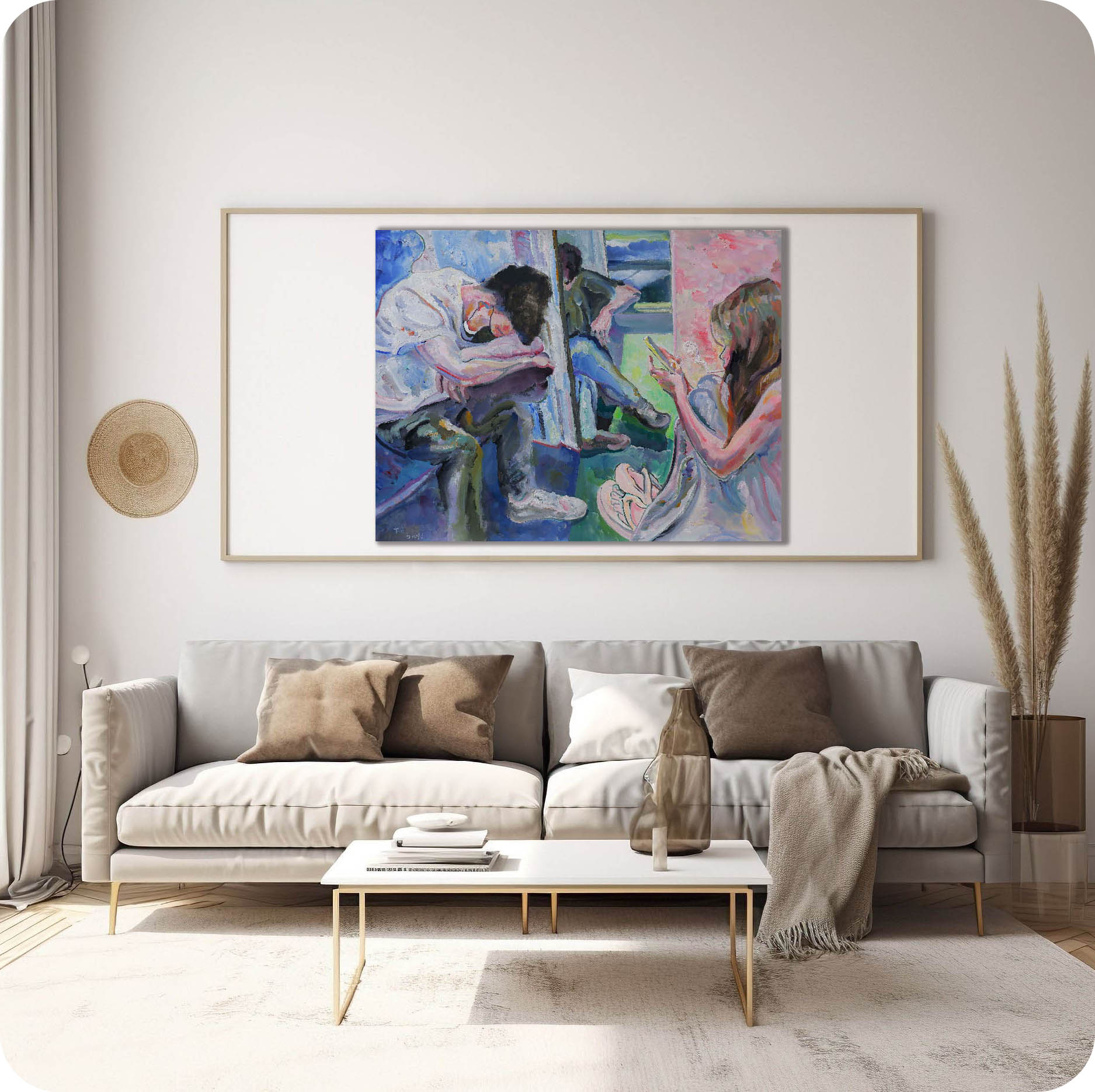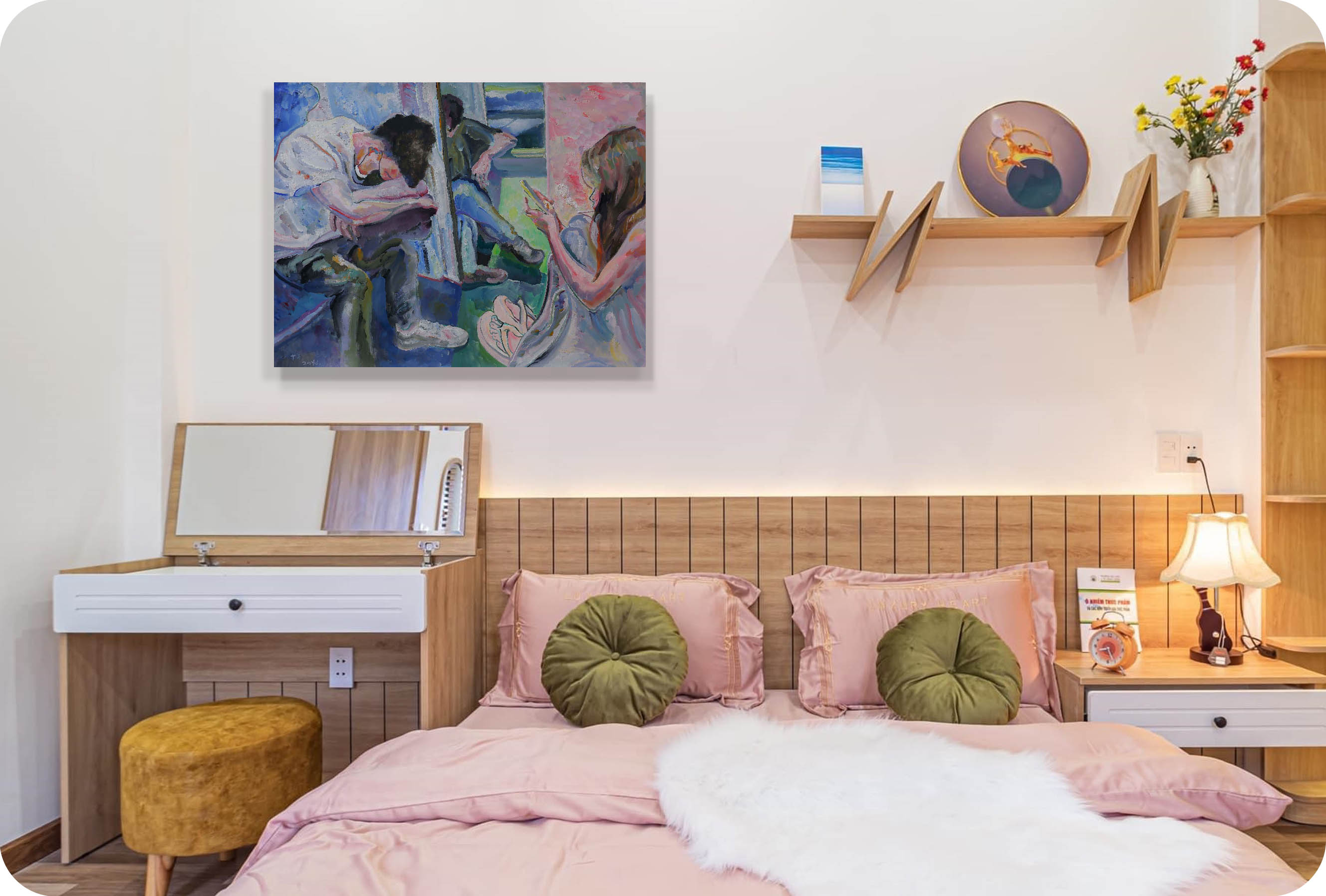This painting was created in 2024. The colors of this year are still bright but not dazzling. I have gradually found a balance point among the bright colors.
Each person occupies a space, and this area gradually acquires a shape, smell, and color unique to him. Although each space is independent and unique, it is not irreconcilable. Consciously or unconsciously, they tentatively allow strange things to invade. Within everything that seems to be full of order, there is hidden the most natural and ambiguous interaction that belongs to this world. All stories start from here.
Inches: x in
Size without the frame: x cm
Country: China
Date: 2024
Materials: Acrylic paint on paper.
Condition: well preserved
Creative themes and style | My works revolve around the creative concept of "The land of humanity, People on the land".The people in the painting are people in nature, and the lines, shapes, and colors are close to nature. The nature in the painting is nature in the eyes of humans, existing in interaction with humans.I don’t pursue a series of works with a fixed and continuous style. I hope that the style of the pictures will synchronize with the changes in my life and always remain oscillating. The performance of the work must be in sync with the development of one's own life in order to be Sincere and powerful.Ideas are later.
An Interview with Artist Philo by Artphiloso Gallery
If you would like to collect this artwork or know more about the artist, please contact us.
painting for drawing room,paintings in a room,pictures for room,rooms to go wall art,wall art room.



1. Subject and Atmosphere
This painting captures an everyday yet contemplative moment: three figures inside what appears to be a train or bus. Each person is absorbed in their own world — one rests his head on folded arms in exhaustion, another leans back with an air of quiet detachment, while a young woman looks intently at her phone. Despite the close quarters, there is little interaction, evoking a subtle sense of isolation within shared space.
2. Gesture and Emotion
The body language of the figures suggests different states of being: fatigue, distraction, and introspection. The man in the foreground, slumped over, conveys the weariness of travel or perhaps of life itself. The figure at the back, half-turned and distant, seems detached, his gaze escaping through the window. In contrast, the young woman on the right, engaged with her phone, reflects the modern tendency to seek solace in digital connection rather than in immediate surroundings. Together, these gestures depict a quiet mosaic of contemporary human condition.
3. Color and Brushwork
The painting’s palette shifts between cool blues, violets, and greens, contrasted with warmer pinks and yellows. These hues not only separate the figures but also unify the composition in a dynamic tension between warmth and detachment. The expressive brushstrokes, layered and fluid, add to the emotional resonance — fatigue, distance, and quiet absorption are conveyed not only through pose but also through the texture of paint itself.
4. Spatial Structure
The composition suggests enclosure, with vertical and diagonal lines shaping a compressed interior. Windows hint at the outside world, but the focus remains inward, on the silent presence of the passengers. This enclosed space reflects both the physical reality of travel and the psychological containment of solitude within a public setting.
5. Conceptual Significance
This painting goes beyond documentary realism. It becomes a reflection on the nature of return, transition, and private worlds within public journeys. Each figure embodies a different mode of inwardness: exhaustion, detachment, digital escape. By weaving these together, the work suggests that modern travel is not merely about physical movement but also about the shifting inner landscapes of people in transit. Art here transforms an ordinary return trip into a meditation on solitude, routine, and the fragmented ways we cope with time.
Edward Hopper, Automat
Exploration of solitude in modern life, with figures isolated in urban settings.
Lucian Freud, Two Men
Raw, expressive brushstrokes revealing the inner states of sitters.
Eric Fischl, The Travel of Romance
Scenes of everyday leisure and travel, infused with psychological depth.
Liu Xiaodong, Hot Bed
Contemporary realist approach, capturing moments of modern life with expressive color and gesture.
This is the artist’s deliberate use of “fluid brushstrokes”, transforming everyday postures inside a train carriage into a dreamlike visual form. The softened edges amplify the sense of fatigue and the passing of time.
The blue-violet suggests nightfall and weariness, while the pink-green implies hope and the sense of a “destination” on the return journey. This clash of colors creates a psychological tension between exhaustion and arrival.
Yes. The one dozing with head down reflects physical exhaustion; the figure leaning and gazing outward shows spiritual drifting; the one absorbed in a phone embodies digital-age self-enclosure. This depiction of “collective solitude” is a hallmark of contemporary group portraiture, making it highly relevant for studies in social psychology and art.
The loose yet heavy brushstrokes give the canvas a sense of movement, echoing the jolting rhythm of the train. The color transitions simulate the shift from dusk to night, intensifying the narrative of time passing on the return journey. Such storytelling methods carry high research and exhibition value within the field of expressionist contemporary painting, especially in exhibitions exploring modern journeys and inner displacement.
Its value lies first in its contemporary subject matter—capturing a fleeting moment of “Return trip” that reflects the psychological state of modern individuals. Second, in its expressive technique, which breaks free from realism and incorporates a sense of “psychological landscape.” As a painting themed around urban experience and modern solitude, it holds significant value for both private collectors and public museums, particularly in exhibitions addressing social themes in contemporary art.
